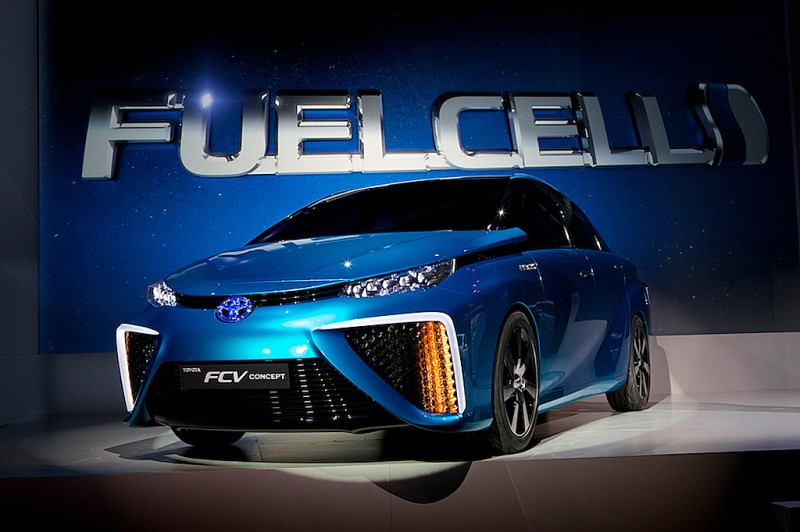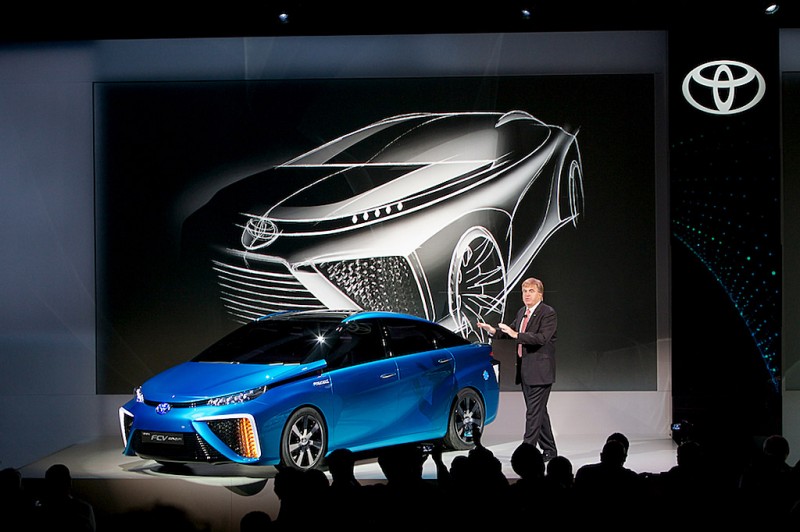Toyota’s new fuel cell vehicle or FCV has made it’s appearance at this year’s International CES 2014 with an interesting demonstration of how owners could simply plug their car into their home, making use of the fuel-cell to generate power for lights and heating.
The Toyota FCV is due to go on sale as soon as 2015 and is essentially an electric car with an on-board electricity generator. The application of the electricity generation into a home is intended for use only in emergency situations, rather than full time use, but there is little reason why not aside from the cost of Hydrogen and that it is not it’s principle design purpose of course.
How long can you power a house for, we hear you ask? Toyota reckons that with a full tank of Hydrogen, the FCV would be able to generate enough energy to supply the average home for as long as a week. As such, Toyota’s engineers are currently working on a junction box which may be used with the car to provide a safe and simple solution to plugging in.
A little about the car itself: The FCV’s driving range is at least 300 miles on a full tank of Hydrogen which gives it a significant edge over the current crop of battery electric vehicles (BEVs). In simple terms, the idea of the hydrogen powered electricity generator being on-board is that it is preferable not to have to carry around stored electricity. One of the reasons why Hydrogen powered vehicles are gaining increasing interest, is due in part to their refilling ability which is essentially the same as that of a petrol or diesel car – drive up to a pumping station, pop the filler cap open, plug in the Hydrogen nozzle and fill up. Simple. In other words, it doesn’t incur the same lengthy times associated with recharging a BEV and the familiarity to petrol and diesel means that FCVs don’t necessitate a change of habits.
So why bother with Hydrogen at all if they’re so much like petrol and diesel? The big bonus, of course, is that the only emission produced is clean water. The problem, at present, is that Hydrogen is the most reactive element in the Universe and so it must be processed before it is first separated and then used as a fuel in it’s elemental state.
There are huge amounts of development going on in this field at the moment, with technology such as solar towers built for the specific purpose of extracting hydrogen from whatever it might be attached to (chemically speaking) and making it into a fuel. However, at the moment the infrastructure simply doesn’t exist for refuelling and as such Hydrogen powered vehicles are an impracticle solution unless you rarely venture further than 150 miles (most people don’t) and you happen to live near to a Hydrogen filling station. Whereas, with battery electric cars that need only connect to a rudimentary plug somewhere, the infrastructure is much more established than even petrol or diesel could claim to be.
Toyota are one of several vehicle manufacturers pursuing Hydrogen technology and are at the forefront of this relatively new drivetrain. They’re not stopping with just making an interesting car with niceties like plugging into your home though, instead Toyota are busying themselves with developing low-carbon homes and integrating vehicles like their hybrid Prius Plug-in to the so called “smart grid” housing developments in Toyota City. Toyota also piloted a similar project in Indianapolis, USA, last year.
As a closing comment, Toyota is not new to plugging in vehicles to power homes. Prius models were seen being used as emergency energy sources in the aftermath of the Japanese earthquake and tsunami of 2011. Though that usage was unofficial, it did highlight that hybrid and electric cars of any sort – not just fuel cell powered versions – could be used to power homes.
Source; Toyota


